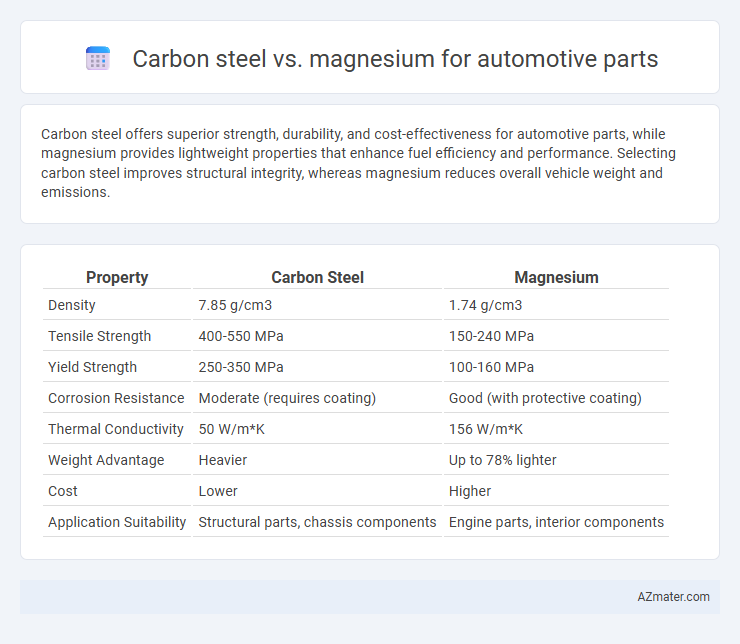Carbon steel offers superior strength, durability, and cost-effectiveness for automotive parts, while magnesium provides lightweight properties that enhance fuel efficiency and performance. Selecting carbon steel improves structural integrity, whereas magnesium reduces overall vehicle weight and emissions.
Table of Comparison
| Property | Carbon Steel | Magnesium |
|---|---|---|
| Density | 7.85 g/cm3 | 1.74 g/cm3 |
| Tensile Strength | 400-550 MPa | 150-240 MPa |
| Yield Strength | 250-350 MPa | 100-160 MPa |
| Corrosion Resistance | Moderate (requires coating) | Good (with protective coating) |
| Thermal Conductivity | 50 W/m*K | 156 W/m*K |
| Weight Advantage | Heavier | Up to 78% lighter |
| Cost | Lower | Higher |
| Application Suitability | Structural parts, chassis components | Engine parts, interior components |
Introduction to Carbon Steel and Magnesium in Automotive Applications
Carbon steel, composed primarily of iron and carbon, offers exceptional strength, durability, and cost-effectiveness, making it a widely used material for automotive parts such as chassis and body panels. Magnesium, known for its low density and high strength-to-weight ratio, provides significant weight reduction benefits, enhancing fuel efficiency and vehicle performance in applications like engine components and interior structures. Both materials balance mechanical properties and manufacturing requirements, driving innovation in automotive design and engineering.
Material Properties: Carbon Steel vs Magnesium
Carbon steel exhibits high tensile strength and excellent durability, making it ideal for automotive parts requiring structural integrity and wear resistance. Magnesium offers a significantly lower density, enhancing fuel efficiency through weight reduction while maintaining good impact resistance and corrosion resistance when properly treated. Selecting between carbon steel and magnesium depends on balancing strength, weight, and corrosion protection requirements for specific automotive applications.
Weight Considerations and Lightweighting Benefits
Carbon steel offers high strength but is significantly heavier compared to magnesium, making it less ideal for weight-sensitive automotive parts. Magnesium provides exceptional lightweighting benefits, reducing vehicle mass by up to 35% compared to traditional steel components. This weight reduction enhances fuel efficiency, lowers emissions, and improves overall vehicle performance.
Strength and Durability Comparison
Carbon steel offers superior tensile strength and durability compared to magnesium, making it ideal for automotive parts subjected to high stress and impact. Magnesium is significantly lighter, providing weight reduction benefits but generally exhibits lower strength and reduced resistance to wear and fatigue. Manufacturers often balance these properties by using carbon steel for structural components requiring high strength and magnesium for parts where weight savings and moderate durability are prioritized.
Corrosion Resistance in Automotive Environments
Carbon steel exhibits lower corrosion resistance in automotive environments compared to magnesium alloys, which naturally form a protective oxide layer enhancing durability. Magnesium's lighter weight and corrosion-resistant surface make it preferable for components exposed to moisture and road salts. However, appropriate coatings and treatments can significantly improve carbon steel's corrosion resistance for automotive applications.
Machinability and Manufacturing Processes
Carbon steel offers superior machinability compared to magnesium due to its consistent hardness and thermal conductivity, enabling precise cutting and shaping during manufacturing. Magnesium's lightweight properties benefit automotive parts by reducing vehicle weight and improving fuel efficiency, but its machinability challenges require specialized tooling and cooling techniques to prevent ignition or damage. Manufacturing processes for carbon steel components typically involve traditional stamping, forging, and welding, while magnesium parts often use die casting and CNC machining to accommodate its reactive nature and complex geometries.
Cost Analysis: Carbon Steel vs Magnesium
Carbon steel offers lower material costs compared to magnesium, making it more economical for high-volume automotive part production. Magnesium's higher cost is attributed to complex extraction and alloying processes, yet it provides significant weight reduction benefits that can lead to fuel efficiency savings over the vehicle lifespan. When analyzing total cost of ownership, carbon steel remains cost-effective for structural components, while magnesium suits applications where weight savings justify the initial material investment.
Environmental Impact and Sustainability
Carbon steel offers high recyclability and durability, contributing to lower environmental impact by reducing the need for frequent replacements in automotive parts. Magnesium, noted for its lightweight properties, enhances fuel efficiency and reduces vehicle emissions, supporting sustainability objectives. However, magnesium production consumes more energy and involves extraction processes with higher ecological footprints compared to the simpler recycling of carbon steel.
Common Automotive Parts Using Each Material
Carbon steel is commonly used in automotive components such as chassis frames, engine blocks, and suspension parts due to its high strength, durability, and cost-effectiveness. Magnesium alloys are typically found in lightweight parts including steering wheels, gearboxes, and seat frames, valued for their excellent strength-to-weight ratio and corrosion resistance. The choice between carbon steel and magnesium depends on balancing weight reduction with mechanical performance requirements in automotive design.
Future Trends in Automotive Material Selection
Carbon steel remains a dominant material in automotive manufacturing due to its high strength, durability, and cost-effectiveness, but emerging trends increasingly favor magnesium alloys for their superior lightweight properties and potential to improve fuel efficiency and reduce emissions. Advances in magnesium processing and corrosion resistance are accelerating its adoption in structural and body components, aligning with automakers' goals for sustainability and electric vehicle performance. Future automotive material selection will likely involve hybrid structures that optimize carbon steel's robustness with magnesium's lightweight advantages to meet evolving regulatory standards and consumer demand for eco-friendly vehicles.

Infographic: Carbon steel vs Magnesium for Automotive part
 azmater.com
azmater.com